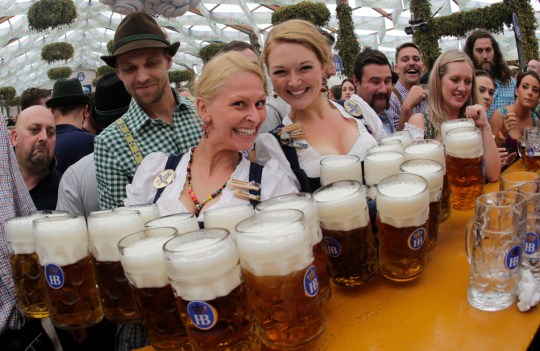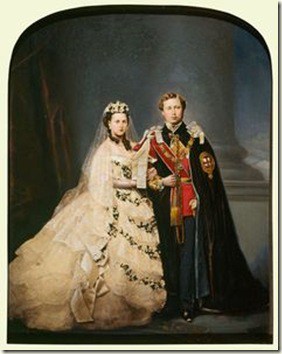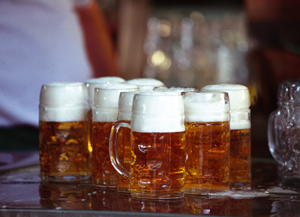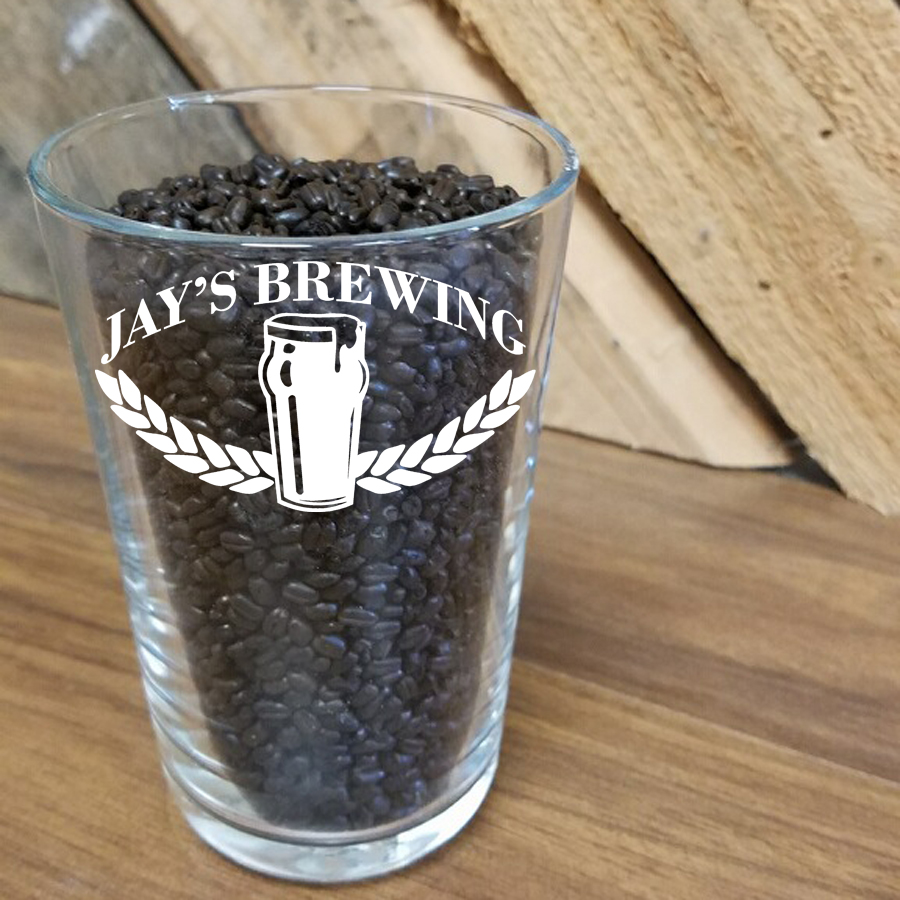
It’s October, so that means cooler weather, changing leaves, kids back in school, and fall/harvest festivals. With festivities comes lots of fun, food, and many different varieties of festive beers. When I think of a fest beer I think of a heavy rich beer with scents of and flavors of spice and holiday cheer. But it’s not cold yet! How can I possibly drink a heavy, high gravity beer when the leaves are still green and on the trees?
Well, the Germans thought about this too. Their answer is the Oktoberfest beer. The style is named after the famous folk festival held annually in Munich, Germany from mid September through the first weekend of October. This festival is close to the heart of every Bavarian, and has been held for the last 215 years.
The festival was first held on October 12, 1801 in celebration of the wedding of Kronprinz Ludwig of Bavaria to Princess Therese of Saxony-Hildburghausen.
 The citizens of Munich were invited to attend the festivities which were held just in front of the city gates in an area named Theresienwiese (Theresa’s Meadow) in honor of the Crown Princess. The festival continued annually, and grew larger every year. Beer was first served in the iconic glass Oktoberfest mugs in 1882. Soon after, the festival was reorganized, allowing the beer booths to become the great halls they are today. Since 1950 Oktoberfest has always had the same opening ceremony. The mayor of Munich taps the first keg of Oktoberfest at twelve noon with the proclamation “O’zapft ist!” (“It is tapped!”). Then he gives the first liter to the Minister-President of the State of Bavaria.
The citizens of Munich were invited to attend the festivities which were held just in front of the city gates in an area named Theresienwiese (Theresa’s Meadow) in honor of the Crown Princess. The festival continued annually, and grew larger every year. Beer was first served in the iconic glass Oktoberfest mugs in 1882. Soon after, the festival was reorganized, allowing the beer booths to become the great halls they are today. Since 1950 Oktoberfest has always had the same opening ceremony. The mayor of Munich taps the first keg of Oktoberfest at twelve noon with the proclamation “O’zapft ist!” (“It is tapped!”). Then he gives the first liter to the Minister-President of the State of Bavaria.
True Oktoberfest beer can only be made by the six breweries that are within the Munich city limits (Augustiner-Bräu, Hacker-Pschorr-Bräu, Löwenbräu, Paulaner, Spatenbräu, Staatliches Hofbräu-München), and must conform to the Reinheistgebot. Traditional Oktoberfest beers are actually Märzen lagers with abv’s between 5.5 and 6%. Many of the modern American examples would be categorized as a festbier, and thus judged by different criteria. The original Märzen’s were dark lagers, but in 1872 Gabriel Sedlmayr and Anton Dreher, owners of Spaten Brewery in Munich, and Dreher in Vienna, brewed an amber-red Vienna lager which became a crowd favorite. This style became known as the Oktoberfestbier and has slowly grown lighter over time, with all beers being a golden color today. Most of the Munich breweries still make the darker Märzen, but it is primarily for export.
In Germany Märzen is a broad category, which can vary from Helles Märzen (light, pale), to Dunkles Märzen which is a deep brown. They all will have a medium to full body, with a malty flavor and a clean, dry finish. Märzen has its roots in 15th century Bavaria, where beer was brewed only between September and April. The summer was too hot to control fermentation and, in these days before the advent of sanitation, would create sour or medicinal beers. Märzen was traditionally brewed in March (German: März) and then cellared in cool caves through the summer, bottled or casked in September and ready to be drunk in early October. Although these beers would have been fine to drink throughout the summer months, they were strongly hopped and required age to come into their own. By the time the autumn chill crept into the air Märzen would have much more complex notes of malt and barley held up by a more mellow hop flavor. At harvest time the casks and barrels would need to be drained of the remaining beer from last year and the past springs to make room for the next batch, so Märzen became a logical choice for every German fall festival.
The lighter style of Märzen first created by Sedlmayer and Dreher eventually became know as the “Vienna Way” and paved the way for the Vienna Lager style. In 1871 Spaten introduced a new interpretation of the Vienna style by using a slightly darker version of Vienna malt which would eventually be called Munich malt. This new style would be marketed under the branded name of Oktoberfestbier, and is what we now consider to be Oktoberfestbier.
 With the push into the 20th century beer production methods changed greatly from those that had been in practice in the middle ages. The science behind creating beer evolved, and the practice became more streamlined. With the advent of refrigeration the Märzen style could be made any time of year, the rush to produce and store a beer before the heat of the summer was no longer a concern. Over time the lagering process also became more efficient, and many Märzen today are bottled as soon as the beer is ready, many times in less than eight weeks. As a rule of thumb, if the bottle carries the whole Märzen-Oktoberfest label it has had the luxury of lagering and maturation of up to 16 weeks.
With the push into the 20th century beer production methods changed greatly from those that had been in practice in the middle ages. The science behind creating beer evolved, and the practice became more streamlined. With the advent of refrigeration the Märzen style could be made any time of year, the rush to produce and store a beer before the heat of the summer was no longer a concern. Over time the lagering process also became more efficient, and many Märzen today are bottled as soon as the beer is ready, many times in less than eight weeks. As a rule of thumb, if the bottle carries the whole Märzen-Oktoberfest label it has had the luxury of lagering and maturation of up to 16 weeks.
 As with any other beer style Oktoberfest is much more complex than what meets the eye. There are many different subcategories that fit under the umbrella of Oktoberfest. From the humble Märzen made by monks and peasant farmers to the classic beer of men in lederhosen, playing in oompah bands. Though there are many variations, you should find the style that you enjoy and celebrate the change of season with all of your best friends!
As with any other beer style Oktoberfest is much more complex than what meets the eye. There are many different subcategories that fit under the umbrella of Oktoberfest. From the humble Märzen made by monks and peasant farmers to the classic beer of men in lederhosen, playing in oompah bands. Though there are many variations, you should find the style that you enjoy and celebrate the change of season with all of your best friends!
Prost!


October 26, 2016 at 4:19 pm
Here’s my grain bill for this style.
43% Munich
43% Vienna
9% Pilsner
5% Brumalt
October 26, 2016 at 6:21 pm
Well done; I hadn’t researched it too much but was wondering why I occasionally had a hard time understanding exactly what Oktoberfest beer was. Side story: we planned our honeymoon in 2015 around Oktoberfest. I’d been a hop-head since the early 00’s and had never liked lagers or really anything but IPA’s, so during that entire time in Munich I still wasn’t a fan of German lagers. Ironically, just six months later (and six months ago) I had a Ballast Point Longfin Lager and for some reason it rocked my world. Ever since I’ve been devouring all beers Munich including American versions of them. I’d love to head back to Munich someday now that I “get it”.
October 26, 2016 at 8:29 pm
There is so much more to beer than just hops! I personally enjoy the nuance that malts and yeasts bring to the palate, and find that there are times when the hops are simply overpowering.
Obviously, I am not a hop-head and I also understand that there are many nuances and flavor profiles associated with hops, so don’t be offended if I seem to talk hops down a little!
There are so many amazing Central European styles out there with different degrees of hoppiness, many of them lagers because of the natural climate of their locale.
I would suggest exploring the different brews that adhere to the reinheitsgebot (I’ll be discussing it in an upcoming article), and see how many different flavor profiles you can make while so restricted! Many American brewers also like to create their own takes on the classic Bavarian brews, and make shockingly good examples.
October 26, 2016 at 8:55 pm
I know that now and knew that before, at least intellectually. I had my first Samuel Adams back in about ’92 and never looked back. I found IPA’s somewhere in the late 90’s and slowly but surely over the years my taste buds kept needing more hops to get the same “high”. The past 15 years or so I really did try to like other beers but nothing compared to an IPA for me. It was about 2 years ago that I apparently, not yet knowing it was becoming a trend (IPA 2.0), had enough of the hop bombs (specifically referring to the bittering hop charge) and started really enjoying balanced pale ales and IPA’s. But man, I get it now. This fall I must have purchased at least 15 brands of Marzens and what would were named Oktoberfest beers and absolutely love and enjoy the balance and even the maltiness. I have yet to brew a lager of any kind but I have a dedicated fermentation fridge and my kegerator can hold an extra keg so that I can lager it. Next year I plan on making my own Oktoberfest that will lager for the whole summer too(!).
October 26, 2016 at 7:14 pm
A good and informative blog. but……To many commercial enterprises sell Oktoberfest beer kits too late in the year.
The time to be thinking about that is in the Spring :-), June at the latest.
October 26, 2016 at 8:19 pm
Classically you are right! In order to get the correct lagering time you should have it in a chilled fermenter by mid spring. Unfortunately most people aren’t thinking about Oktoberfest until October, when the actual celebration is nearly over. The beer kit producers are going to sell more Oktoberfest kits in the fall than any other time of year, so that’s when they try to sell them.
Here is a handy link to a brewing calendar on the Jay’s website:
https://www.jaysbrewing.com/2011/11/26/the-ultimate-brewing-calender/
If you’re like me, you like to think ahead and have beers ready to go for the correct season to be drinking them.